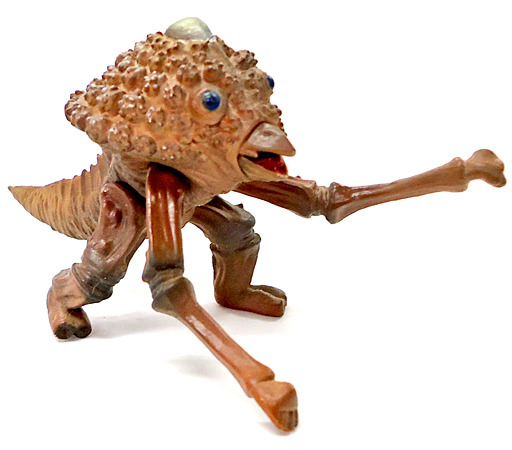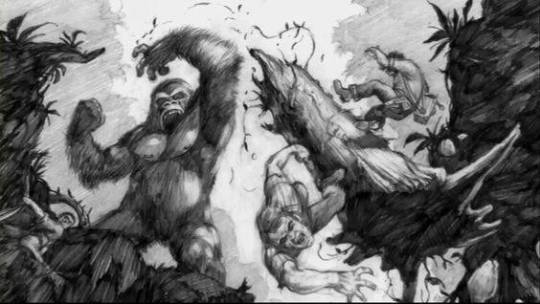#UNMADEFILMS
Text
Odd thought
I hope the Gamera anime leaves room for a sequel and it gets made, and because they used almost all their classic kaiju they have to use new ones or some from hopefully umaded films. This is mainly because I want to hear fans try to pronounce Marukobukarappa, possibly the most awkward kaiju name ever. Guy had only concept art and a model shown on a 1991 DVD feature, but got a toy.

0 notes
Text
BACKSTORY
Both Stuart Gordon and his producer Brian Yuzna had talked about doing the film ever since they’d first teamed up for Re-Animator. “It’s always been my favorite Lovecraft story,” beams Gordon. “At one time, it looked like we were going to do it in England.”
Scheduling conflicts on Gordon’s other “Italian” pictures prevented the deal from taking off. It wasn’t until a couple of years ago that a major studio and distributor finally expressed a sincere enough commitment to actually begin financing the project. “We set it up with Vestron,” Gordon recounts. “I had originally told them it would cost about $5 million. Vestron came back and said if we could do it for $4 million, we had a deal.”
Unlike other studio blowhards, Vestron put their money where their mouth was. “Vestron set us up in a production office,” Gordon details. “Brian and I did some location scouting through New England Massachusetts, Maine-and we managed to find an isolated town in Maine that was very much like Innsmouth. We also had the whole movie storyboarded and scheduled.”
Berni Wrightson, gifted illustrator and comics superstar hailed for Swamp Thing, was contacted and asked to consider the role of concept artist. Wrightson, is considered by his peers to have one of the finest hands in the business. His flowing, evocative pen-and-ink work is unparalleled in the graphic arts. Wrightson eagerly accepted the job. “It was the most fun experience I’ve ever had,” he attests. “I like working with Stuart. I loved Re-Animator, it reanimated me.”
This slideshow requires JavaScript.
Like many. Wrightson remembers being disillusioned with the state of the horror film at the time he saw Re-Animator during its initial theatrical release. Then everything changed, forever. “I’d lost interest in horror films until I saw Re-Animator,” Wrightson confesses. “I’d given up. The imagination had gone out of them. It just wasn’t fun. Jason, Freddy, Michael-how can people keep coming back for the same old shit? I went to ReAnimator without any expectations, and I was absolutely delighted from the opening shot. It was like sitting through a real-life story from EC comics, drawn by Jack Davis.”
Wrightson had been devouring the works of H.P. Lovecraft since childhood and leapt at the chance to work on Shadow Over Innsmouth with a director he so admired. Wrightson had been out for the day and returned to find a phone message. His wife told him somebody named Gordon had called. “I wondered if it was the Stuart Gordon,” Wrightson gushes.
“Berni did some fabulous drawings and paintings for us,” Gordon praises. “He did a great job visualizing the creatures and making them scary. He played with the mutation idea. This wasn’t like a Planet of the Apes basic mask; each person had been affected in a different way.”
Wrightson worked nonstop for over a month and produced close to 70 drawings. Most were graphite illustrations, though several were done in color with mixed media. “Stuart told me to go crazy with it. We never settled on just one look,” Wrightson concurs. “Stuart kept wanting more and different designs. We had humanoid tadpoles, octopi, weird creatures with fins coming out of their ears.” The artist faithfully heeded Gordon’s directions and delivered a plethora of bizarre amphibious creatures that would eventually lead to a slight degree of consternation once the concepts were delivered to FX supervisor and makeup icon Dick Smith. “Dick called me.” Wrightson remembers, “and kind of scolded me, saying it wasn’t humanly possible. ‘You’ve got to have a human being under this stuff!
“Scolded’ is a bit strong.” smiles Smith, currently at work on Francis Coppola’s third Godfather film, “but this is a problem makeup effects people have with artists who work in two dimensions: You can draw anything you want-omit the brain pan, the cavity-yet then some designs can’t be done on a human being.”
Smith sculpted several full-size heads in addition to casting some prosthetic pieces designed as facial appliances. “I did a rough foam latex mouth and stuck it on somebody to see how it worked,” he discloses. “I was trying to avoid mechanical masks; they’re expensive and often counterproductive.” After the initial makeups were designed and proven viable, Smith was to act only as the film’s FX supervisor and consultant, with other crews employed to complete the actual fabrication and application. “The people I recommend are good enough that I’m not needed,” Smith adds. He picked Greg Cannom to execute the complex appliance makeup on the major characters because, “I saw a sculpture of his that I liked better than mine. His work is very organic.” John Caglione and Doug Drexler were to manufacture and apply the various other makeups and prosthetics needed for the close background creatures, as well as the slip-on masks to be worn by extras during the mob scenes.
Though by this time many participants’ hopes had been propelled to stratospheric heights, a Shadow Over Vestron began to gather, casting serious doubts on the ultimate feasibility of the project. Other production companies had expressed similar trepidation in the past, mostly because of the ambitious scope of the story.
“It’s a big picture,” Gordon explains. “You’re dealing with things that are notoriously scary for producers: lots of makeup effects, lots of water, needing an actual town for location shooting. And then there’s the story. The basic idea was a problem. If you explain it to another person, it sounds absurd. The idea of people turning into fish sounds like a joke.” Future developmental plans and preproduction meetings would refer to the mutants as “amphibious creatures.”
Both Gordon and writer Dennis Paoli knew that they also had to add some modern touches to a story that Lovecraft had set in the 1920s. Gordon, Paoli and producer Yuzna all had a hand in the original treatment, but it was up to Paoli to write a script that would measure up to show biz standards.
“What can I do to adapt to a ‘Hollywood’ viewpoint?” asks Paoli rhetorically. “Add a woman, since very few Lovecraft stories include women; speed the pace up, because Lovecraft is atmospheric; you have to have a scene at the beginning the hook, something that quickly tells the whole story.”
Special Makeup Effects supervised by Dick Smith
Special Makeup Effects supervised by Dick Smith
At one time, The Shadow Over Innsmouth was envisioned as a period piece. As Paoli notes, “Lovecraft feeds off the darkness of the 19th century, the puritanical side of New England culture.” Budgetary restrictions and commercial viability soon swayed the production team into a more modern approach. The town in Maine was replaced by one in Washington state. A fishy love story was added as subtext. Parts of another Lovecraft story, “The Thing on the Doorstep,” were added in order to heighten the drama. Gordon further isolated the town until it was entirely cut off from its neighboring burg. “We made it an island,” says Gordon, “so you had to take a ferry to get there.
Both of the major location sites offered enthusiastic townspeople who were willing to do nearly anything to attract the film company. “They offered themselves as extras, said we could blow up a dockside building,” Gordon recalls appreciatively. “They were willing to let us do whatever we wanted to shoot the film in their town.”
However, both Gordon and Yuzna soon realized that their imaginations were running far ahead of the budget. Vestron was fairly adamant about the set figure and Gordon began to be haunted by the additional $3 million he figured would be needed to do the treatment justice. “It became very frustrating.” Gordon recalls. “The further we got into it, we realized it couldn’t be made for that. For less than $7 million, you would lose what made Shadow so special in the first place.”
Vestron refused to budge. Gordon counters, “For $4 million, there could be no town, probably just a house, with one family turning amphibious. We had a climactic sequence taking place on the reef; that too would have to go. Probably there would be no water in the story at all.”
Gordon arrived at a point where he knew the compromised version would be so far removed from Lovecraft that there would be no point in calling it The Shadow Over Innsmouth. “It was a mutual realization,” Gordon sighs. “We all knew we just couldn’t do it right for $4 million.” Despite Gordon’s overall cheerfulness and enthusiasm, it is at this point that a hint of genuine sadness and frustration begins to creep into his voice. This project obviously meant a helluva lot to all of them.
“It was a wonderful story,” adds Dick Smith. “It’s just a pity that the producers were stuck with the budget. Stuart didn’t want to do it half-assed, and I respect him for that.”
CREDITS/REFERENCES/SOURCES/BIBLIOGRAPHY
FANGORIA#106
BEST OF FANGORIA 9
Empire Pictures – Shadow Over Innsmouth (1985/1991) Unfilmed BACKSTORY Both Stuart Gordon and his producer Brian Yuzna had talked about doing the film ever since they'd first teamed up for Re-Animator.
0 notes
Photo

A film can have various battles and struggles in its production, and there are many that we unfortunately never got to see. So many that we plan on revisiting this list, but for now here are five random unmade films we wish we saw!
http://www.chillpress.com/films_five_unmade_films.php
#unmadefilms#film#cinema#filmhistory#cinemahistory#kubrick#stanleykubrick#kenrussel#dracula#napoleon#marx#marxbros#dali#salvadordali#clairnoto#thetourist#hitch#hitchcock#alfredhitchcock#kaleidoscope
0 notes
Text
The remake we deserved: King King (1996)
King Kong 1996 is the Peter Jackson remake we deserved. Don't @ me. #kingkong #kong #peterjackson #unmadefilms
With Paramount having taken their crack at the 8th Wonder of the World with King Kong (1976) and King Kong Lives (1986), the ball was back in Universal’s court to make their own version of the Skull Island epic.
It had been ten years since Paramount released its follow-up to the 1976 King Kong remake entitled King Kong Lives, and Universal was once again hungry for some of that Kong cash. It may…

View On WordPress
#Bruce Campbell#Gary Oldman#George Clooney#Kate Winslet#King Kong#King Kong 1996#King Kong 2005#Peter Jackson#Robert DeNiro
1 note
·
View note
Photo

Uriel Orlow, 'Unmadefilm The Reconnaisance' (2012-13)
Photo: Castello di Rivoli
1 note
·
View note
Photo

Disney has given us an endless amount of entertainment, though we have also lost so many possibly great projects along the way that just didn't make it. Here are ten unmade Disney films we wish we could have.
http://www.chillpress.com/films_disney_unmade_films.php
#film#animatedfilm#animation#disney#waltdisney#nostalgia#unmadefilm#fraidycat#animationhistory#animated#wildlife#fantasia#musicana#hiawatha#countrycousin#chanticleer#reynard#thefox#mypeoples#mort#terrypratchett#discworld
0 notes